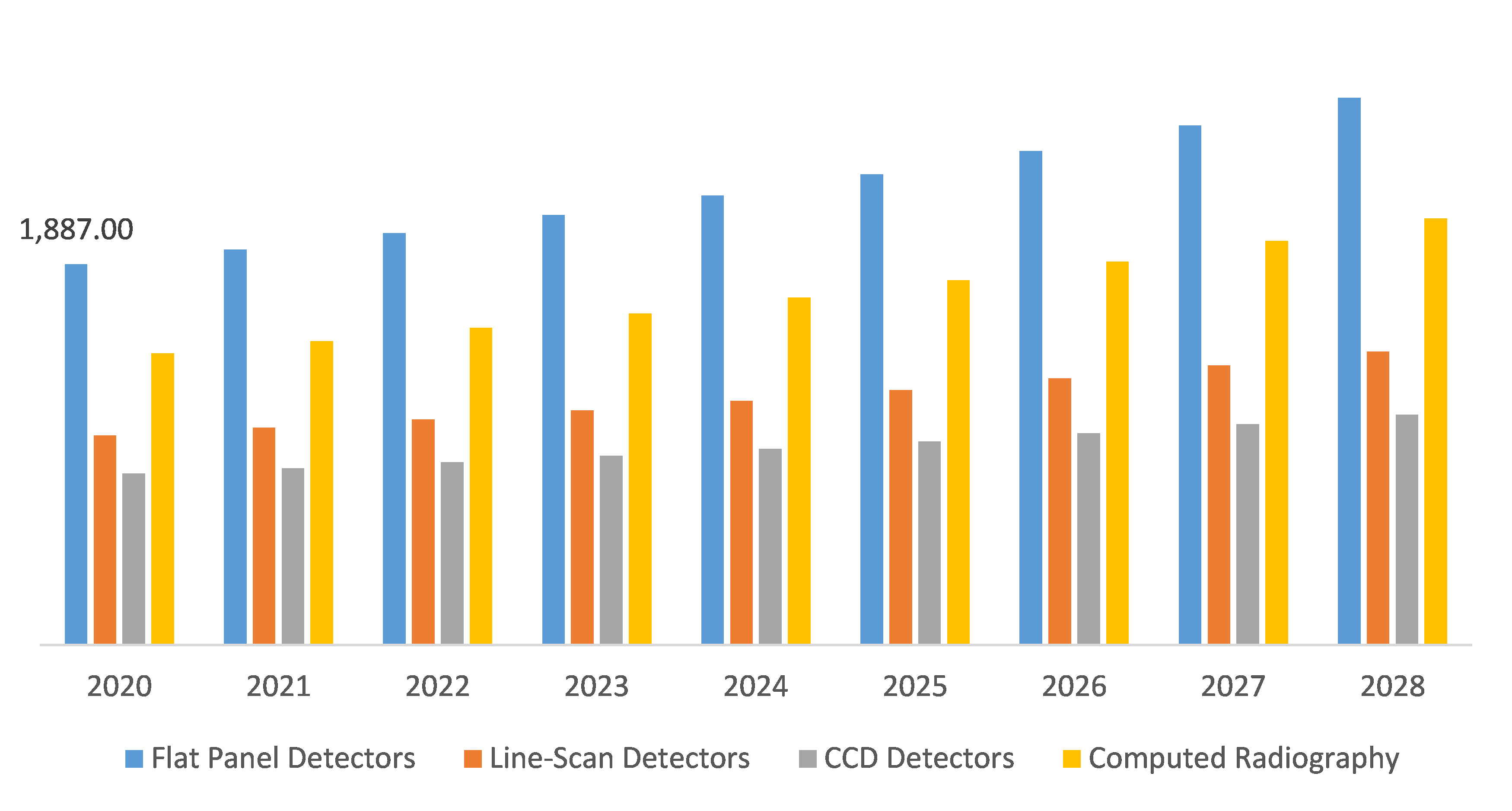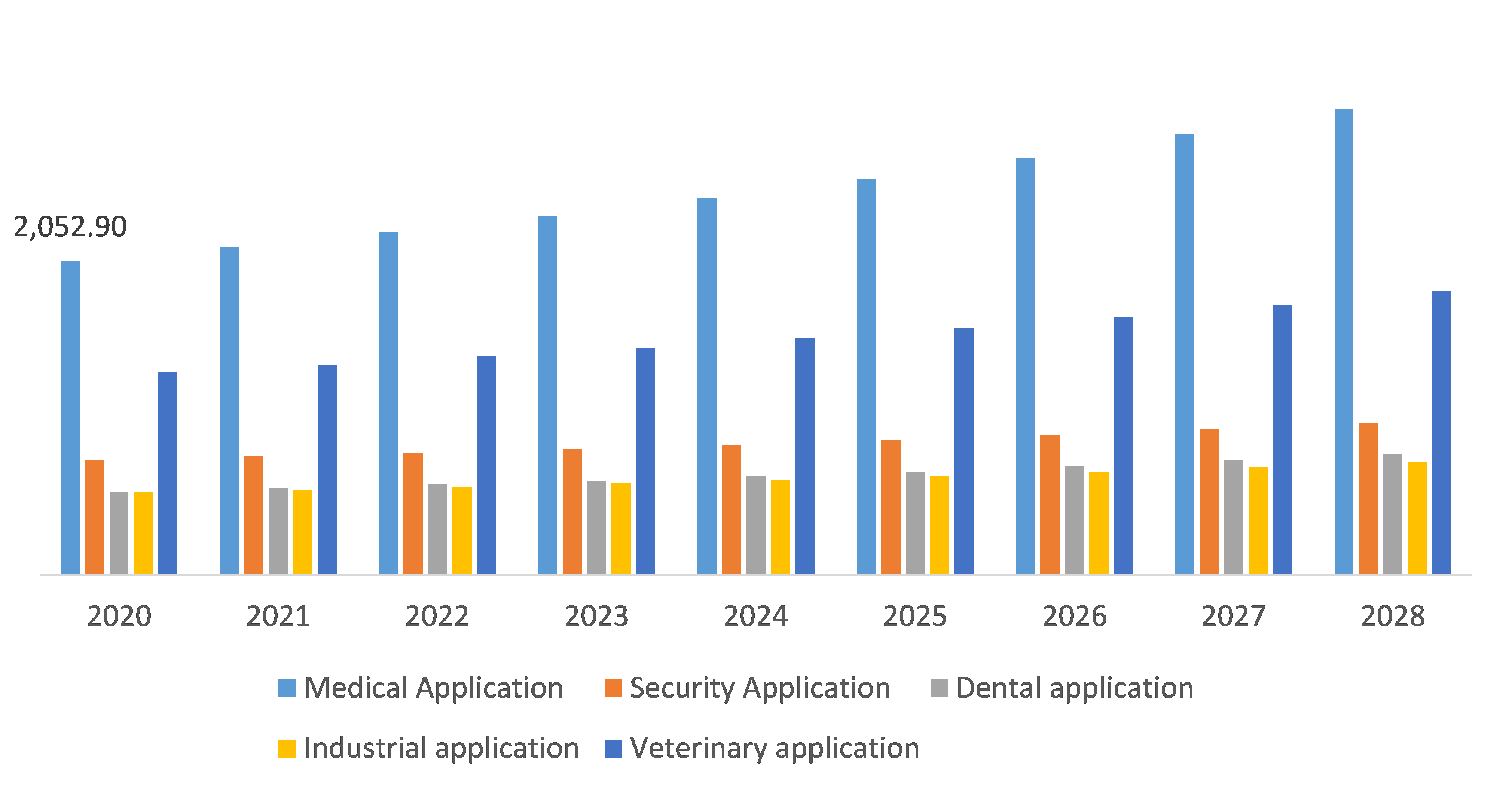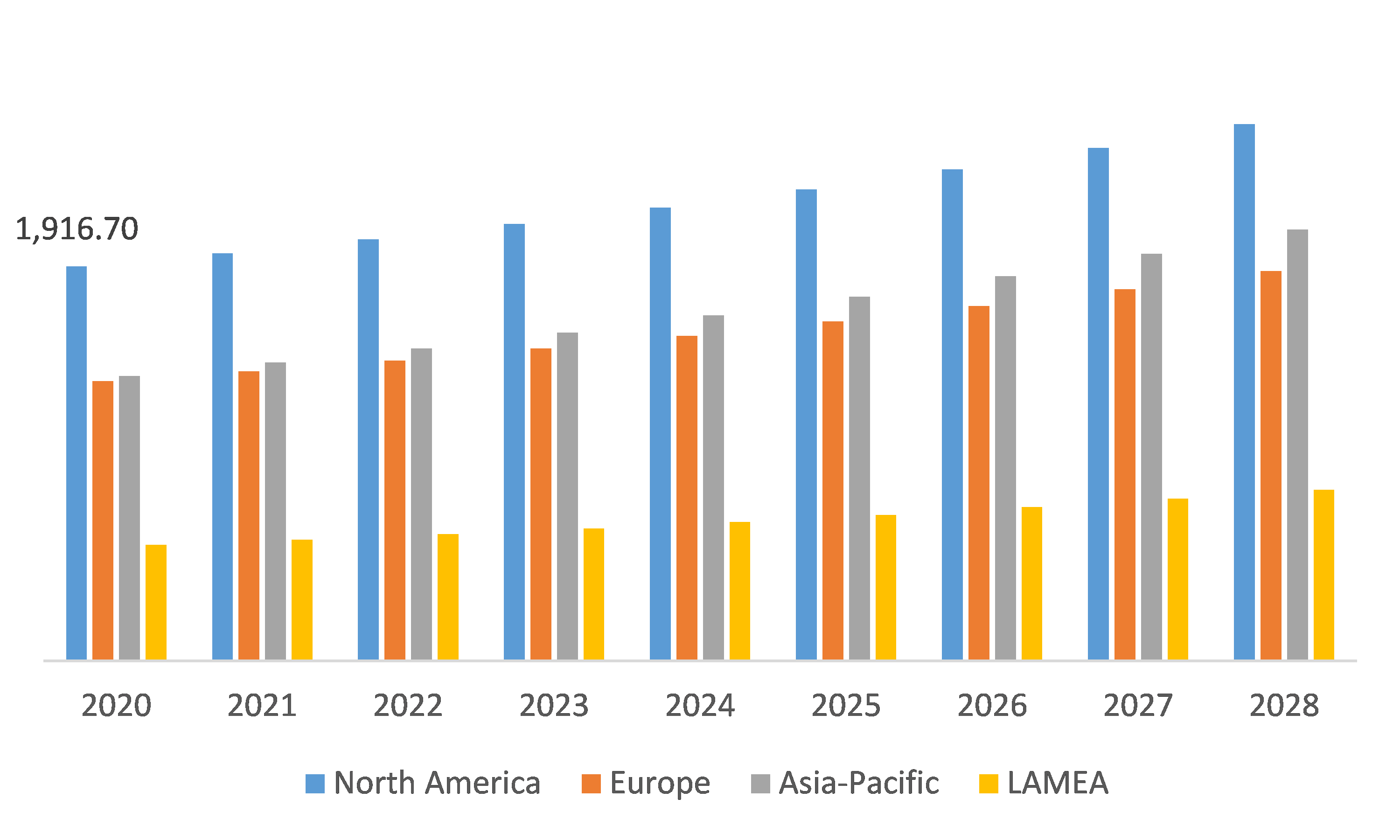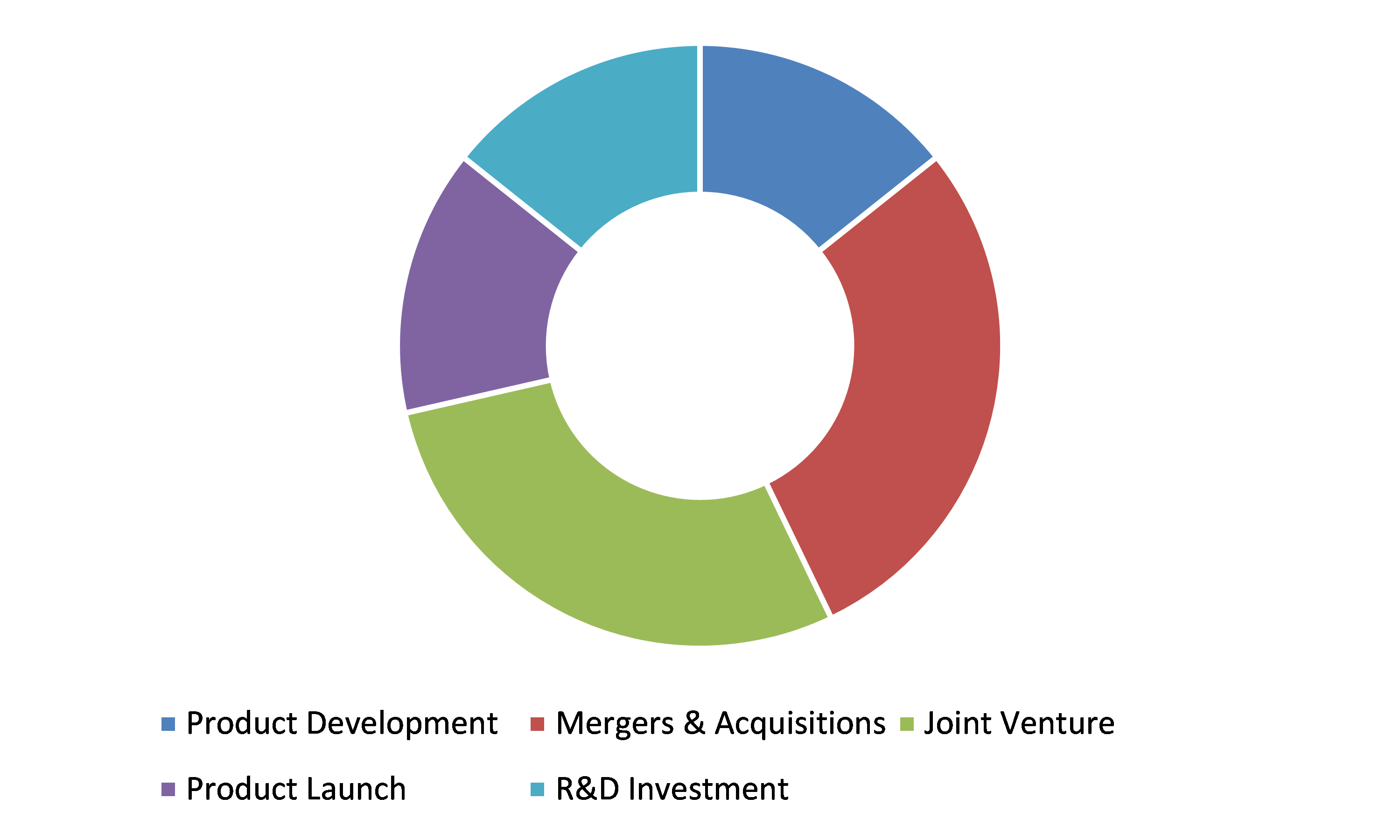X-ray Detectors Market Report
RA01572
X-ray Detectors Market by Type (Flat Panel Detectors, Line-scan Detectors, CCD Detectors, and Computed Radiography), Application (Medical Application, Security Application, Dental application, Industrial application, and Veterinary application), and Regional Analysis (North America, Europe, Asia-Pacific, and LAMEA): Global Opportunity Analysis and Industry Forecast, 2021–2028
Global X-ray Detectors Market Analysis
The global x-ray detectors market is predicted to garner $7,426.5 million in the 2021–2028 timeframe, growing from $5,222.6 million in 2020 at a healthy CAGR of 4.60%.
Market Synopsis
Strategic alliances among market players, along with introduction of smart and effective x-ray devices, for example filmless imaging machines is expected to accelerate the growth of the x-ray detectors market.
However, higher cost of digital x-ray and stringent government regulations are some of the growth-restricting factors for the market.
According to the regional analysis, the Asia-Pacific x-ray detectors market is anticipated to grow at a CAGR of 5.40% during the review period due to increasing budget allocation and research activities in the healthcare sector.
X-ray Detectors Overview
X-ray detectors are devices that are used to measure the properties of x-rays and they transport x-ray radiations into electronic forms. Therefore, they are majorly used in medical imaging for creating images of body structures and tissues. Also, x-ray detectors are used in dental, industrial, and security industries for imaging.
Impact Analysis of COVID-19 on the Global X-ray Detectors Market
Though the novel coronavirus pandemic had a devastating effect on several industries, the x-ray detectors market had experienced an upliftment during this period, owing to its diagnostic imaging facilities. Moreover, during the pandemic, the use of chest x-rays to detect the presence of the coronavirus along with pneumonia in lungs has increased. Therefore, the importance of x-ray detectors has skyrocketed, driving the growth of the market.
In addition to this, several researches are ongoing during the pandemic for helping the society recover from the chaotic situation. For instance, Louisiana State University Health Sciences Center New Orleans, in September 2020, announced that they had conducted a study on approximately 400 people to study the effects of COVID-19. They evaluated the RT-PCR and chest x-rays and experienced that chest x-rays are 96.6% accurate in detecting SARS-CoV-2. The above-stated factors show that the pandemic may generate substantial investment opportunities in the market in the coming years.
Increasing Use of X-ray Detectors in Orthopedic to Surge the Market Growth
The global x-ray detectors industry is witnessing a massive growth mainly due to an increase in the detection of orthopedic and other diseases. Orthopedic doctors are often using x-ray detectors to obtain clear images to understand the ailment or injury. Carestream, a worldwide provider of medical imaging systems and IT solutions, in June 2019, announced that they had launched small-format Carestream DRX Plus 2530C X-Ray Detector with cesium iodide technology. The x-ray detector is designed in such a way that it has a resolution of 98 microns for delivering smallest anatomical structures that are present in pediatric patients.
The emergence of x-ray detectors in industrial application is already leading market players to innovate strategies to attract customers. For example, Varex, key market player in x-ray inspection in May 2019, announced that they had launched two different types of x-ray detectors 3020DXV-I and 3030DXV-I. They are designed in a way to offer application inspection services. These types of initiatives from market leaders are also predicted to drive the growth of the market.
To know more about global x-ray detectors market drivers, get in touch with our analysts here.
Higher Cost of X-ray Detectors to Restrain the Market Growth
The x-ray detectors are costlier, and it is expected to restrain the growth of the global market during the forecast period. Also, higher exposure of x-rays can cause various side-effects such as hair loss, bleeding, vomiting, and fainting. Therefore, such factors may create a negative impact on the growth of the market during the forecast period.
Growing Trends of Artificial Intelligence in X-rays to Create Massive Investment Opportunities
The global x-ray detectors market is growing at a very fast pace due to the shifting of x-ray technology towards artificial intelligence for higher sensitivity and specificity of x-ray detectors. Moreover, according to an article in Health Analytics, in September 2019, Intermountain Healthcare and Stanford University announced that they had combined x-ray detectors with artificial intelligence and the device is known as CheXpert system. The system is designed in such a way that it can analyze images in 10 seconds with higher level of accuracy. Therefore, these are major growth accelerating factors of the x-ray detectors, thereby positively affecting the market growth.
Furthermore, key players working in x-ray detectors market are following notable strategies such as product innovation along with strategic tie-ups in order to grow worldwide. For instance, Duke University engineers, in June 2021, announced that they had launched prototype X-ray scanning system. The scanning system is designed in such a way that it is capable of scanning chemical makeup of any type of objects. This technique can offer wide applications in different medical fields such as pathology, geology, cancer surgery and drug inspection, which may further lead to lucrative market opportunities for key players in the upcoming years.
To know more about global x-ray detectors market opportunities, get in touch with our analysts here.
Global X-ray Detectors Market, by Type
Based on type, the market has been divided into flat panel detectors, line-scan detectors, CCD (charge coupled device) detectors, and computed radiography sub-segments of which the flat panel detectors sub-segment is projected to generate the maximum revenue and computed radiography is predicted to show the fastest growth.
Source: Research Dive Analysis
The flat panel detectors type sub-segment is predicted to have a dominating market share in the global market. The sub-segment is expected to register a revenue of $2,713.10 million during the forecast period. The growth of the sub-segment is mainly attributed to its advantages over all other types of x-ray detectors. For instance, flat panel detectors are less expensive, faster, and sensitive. Moreover, key players operating in the market are adopting strategic collaborations to offer best type of x-ray detectors to customers. For instance, Thales and NEHS, key players in healthcare system, announced that they jointly launched Aero DR NS flat panel detector. The flat panel detector is designed in such a way that enables fast detection imaging and diagnostics of diseases in any kind of health emergency. These factors may bolster the growth of the sub-segment during the forecast period.
The computed radiography type sub-segment is predicted to have the fastest growth in the global market. The sub-segment is expected to register a revenue of $2,115.10 million during the forecast period. Computed radiography uses flexible phosphor imaging plate (IP) for capturing diseases digitally, rather than using normal photographic film. Computed radiography does not require chemicals like other detectors. For example, direct conversion flat panel detectors require chemicals like amorphous selenium (a-Se) or cadmium telluride (Cd-Te). Also, images that are produced by computer radiography is highly dynamic. All such factors are anticipated to enhance the computed radiography type of x-ray detectors and it may accelerate the global market growth.
Global X-ray Detectors Market, by Application
Based on application, the market has been sub-segmented into medical application, security application, dental application, industrial application, and veterinary application. Among the mentioned sub-segments, the medical application sub-segment is predicted to show the fastest growth as well as garner a dominant market share.
Source: Research Dive Analysis
The medical application sub-segment of the global x-ray detectors market is projected to have the fastest growth as well as a dominant share. It is also projected to surpass $3,045.90 million by 2028, with an increase from $ 2,052.90 million in 2020. This growth in the market can be attributed to the increasing number of patients with cardiovascular, oncology, dental, orthopedic, and other diseases. The hike could be due to urban residents' changing lifestyles and them having to deal with stress on a regular basis. Moreover, according to National Cancer institute in 2020, more than 1,806,590 new cases of cancer were diagnosed in the U.S. All such elements may surge the market growth.
Global X-ray Detectors Market, Regional Insights:
The x-ray detectors market was investigated across North America, Europe, Asia-Pacific, and LAMEA.
Source: Research Dive Analysis
The Market for X-ray Detectors in North America to be the Most Dominant
The North America x-ray detectors market accounted $1,916.70 million in 2020 and is projected to register a revenue of $2,606.70 million by 2028. The extensive growth of the North America x-ray detectors market is mainly driven by the strong presence of leading x-ray detectors providers such as Varex Imaging Corporation (US), Teledyne DALSA Inc. (US), and Carestream Health (US) who offer trending x-ray detectors that have higher resolution, high detection efficiency, sensitivity, and contrast. Furthermore, increasing budget allocation on research & development activities by the companies and research institutions is also expected to drive the market growth. For instance, Thales, in January 2020, announced that they had launched X-ray detectors for radiography and fluoroscopy. This new technology is expected to open new ways in genome research for studying the genetic mutation in genes as well as protein crystallography. Such developments are likely to advance the growth of the market in the predicted time span.
The Market for X-ray Detectors in Asia-Pacific to be the Fastest Growing
The share of Asia-Pacific x-ray detectors market is anticipated to grow at a CAGR of 5.40% by registering a revenue of $2,094.30 million by 2028. The growth is anticipated due to an increase in the number of geriatrics suffering from chronic diseases like cardiovascular diseases, cancer, and pneumonia in Asian countries like India and China. Moreover, rising medical tourism and healthcare budget, might foster the Asia-Pacific x-ray detectors market, in the upcoming years.
Competitive Scenario in the Global X-ray Detectors Market
Product launches and mergers & acquisitions are common strategies followed by major market players.
Source: Research Dive Analysis
Some of the leading x-ray detectors market players are Siemens AG, Koninklijke Philips N.V, General Electric, Thales Group, Carestream Health, Inc., Rayence Inc., Toshiba, Varex Imaging Nederland B.V., Trixell, and Orvee Medical Solutions.
Porter’s Five Forces Analysis for the Global X-ray Detectors Market:
- Bargaining Power of Suppliers: The service suppliers of x-ray detectors market are high in number and are larger and more globalized. So, there will be less threat from the suppliers.
Thus, the bargaining power of suppliers is low. - Bargaining Power of Buyers: Buyers demand effective x-ray detectors that can scan and detect images in low cost and less time. This has increased the pressure on the x-ray detectors providers to offer the x-ray detectors in a cost-effective way. Thus, many suppliers are offering best yet cost –effective x-ray detectors. This gives the buyers the option to freely choose x-ray detectors that best fits their preference.
Thus, the bargaining power of the buyers is high. - Threat of New Entrants: Companies entering the x-ray detectors market are adopting various innovations such as developing x-ray detectors that uses artificial intelligence.
Thus, the threat of the new entrants is moderate. - Threat of Substitutes: Different types of technologies are available in the market, such as ultrasound techniques and visible techniques but they do not offer services as x-ray detectors.
Therefore, the threat of substitutes is low. - Competitive Rivalry in the Market: The competitive rivalry among industry leaders is rather intense, especially between the global players including Siemens AG, Koninklijke Philips N.V, and General Electric. These companies are launching their value-added services in the international market and strengthening the footprint worldwide.
Therefore, competitive rivalry in the market is high.
| Aspect | Particulars |
| Historical Market Estimations | 2019-2020 |
| Base Year for Market Estimation | 2020 |
| Forecast Timeline for Market Projection | 2021-2028 |
| Geographical Scope | North America, Europe, Asia-Pacific, LAMEA |
| Segmentation by Type |
|
| Segmentation by Application |
|
| Key Companies Profiled |
|
Q1. What is the size of the global x-ray detectors market?
A. The size of the global x-ray detectors market was over $5,222.60 million in 2020 and is projected to reach $7,426.50 million by 2028.
Q2. Which are the major companies in the x-ray detectors market?
A. Siemens AG, Koninklijke Philips N.V, and General Electric are some of the key players in the global x-ray detectors market.
Q3. Which region, among others, possesses greater investment opportunities in the near future?
A. The Asia-Pacific region possesses great investment opportunities for investors to witness the most promising growth in the future.
Q4. What will be the growth rate of the Asia-Pacific x-ray detectors market?
A. Asia-Pacific x-ray detectors market is anticipated to grow at a 5.40% CAGR during the forecast period.
Q5. What are the strategies opted by the leading players in this market?
A. Technological development and strategic partnerships are the key strategies opted by the operating companies in this market.
Q6. Which companies are investing more on R&D practices?
A. Siemens AG, Koninklijke Philips N.V, and General Electric are investing more on R&D activities for developing new products and technologies.
1.Research Methodology
1.1.Desk Research
1.2.Real time insights and validation
1.3.Forecast model
1.4.Assumptions and forecast parameters
1.4.1.Assumptions
1.4.2.Forecast parameters
1.5.Data sources
1.5.1.Primary
1.5.2.Secondary
2.Executive Summary
2.1.360° summary
2.2.By type trends
2.3.By application trends
3.Market overview
3.1.Market segmentation & definitions
3.2.Key takeaways
3.2.1.Top investment pockets
3.2.2.Top winning strategies
3.3.Porter’s five forces analysis
3.3.1.Bargaining power of consumers
3.3.2.Bargaining power of suppliers
3.3.3.Threat of new entrants
3.3.4.Threat of substitutes
3.3.5.Competitive rivalry in the market
3.4.Market dynamics
3.4.1.Drivers
3.4.2.Restraints
3.4.3.Opportunities
3.5.Technology landscape
3.6.Regulatory landscape
3.7.Patent landscape
3.8.Pricing overview
3.8.1.by Type
3.8.2.by application type
3.9.Market value chain analysis
3.9.1.Stress point analysis
3.9.2.Raw material analysis
3.9.3.Manufacturing process
3.9.4.Application analysis
3.9.5.Operating vendors
3.9.5.1.Raw material suppliers
3.9.5.2.Product manufacturers
3.9.5.3.Product distributors
3.10.Strategic overview
4.X-Ray Detectors Market, by Type
4.1.Flat Panel Detectors
4.1.1.Market size and forecast, by region, 2019-2027
4.1.2.Comparative market share analysis, 2019 & 2027
4.2.Line-Scan Detectors
4.2.1.Market size and forecast, by region, 2019-2027
4.2.2.Comparative market share analysis, 2019 & 2027
4.3.CCD Detectors
4.3.1.Market size and forecast, by region, 2019-2027
4.3.2.Comparative market share analysis, 2019 & 2027
4.4.Computed Radiography
4.4.1.Market size and forecast, by region, 2019-2027
4.4.2.Comparative market share analysis, 2019 & 2027
5.X-Ray Detectors Market, by application
5.1.Medical Application
5.1.1.Market size and forecast, by region, 2019-2027
5.1.2.Comparative market share analysis, 2019 & 2027
5.2.Security Application
5.2.1.Market size and forecast, by region, 2019-2027
5.2.2.Comparative market share analysis, 2019 & 2027
5.3.Dental application
5.3.1.Market size and forecast, by region, 2019-2027
5.3.2.Comparative market share analysis, 2019 & 2027
5.4.Industrial application
5.4.1.Market size and forecast, by region, 2019-2027
5.4.2.Comparative market share analysis, 2019 & 2027
5.5.Veterinary application
5.5.1.Market size and forecast, by region, 2019-2027
5.5.2.Comparative market share analysis, 2019 & 2027
6.X-Ray Detectors Market, by Region
6.1.North America
6.1.1.Market size and forecast, by type, 2019-2027
6.1.2.Market size and forecast, by Application , 2019-2027
6.1.3.Market size and forecast, by country, 2019-2027
6.1.4.Comparative market share analysis, 2019 & 2027
6.1.5.U.S.
6.1.5.1.Market size and forecast, by Type, 2019-2027
6.1.5.2.Market size and forecast, by Application , 2019-2027
6.1.5.3.Comparative market share analysis, 2019 & 2027
6.1.6.Canada
6.1.6.1.Market size and forecast, by Type, 2019-2027
6.1.6.2.Market size and forecast, by Application , 2019-2027
6.1.6.3.Comparative market share analysis, 2019 & 2027
6.1.7.Mexico
6.1.7.1.Market size and forecast, by Type, 2019-2027
6.1.7.2.Market size and forecast, by Application , 2019-2027
6.1.7.3.Comparative market share analysis, 2019 & 2027
6.2.Europe
6.2.1.Market size and forecast, by Type, 2019-2027
6.2.2.Market size and forecast, by Application , 2019-2027
6.2.3.Market size and forecast, by country, 2019-2027
6.2.4.Comparative market share analysis, 2019 & 2027
6.2.5.Germany
6.2.5.1.Market size and forecast, by Type, 2019-2027
6.2.5.2.Market size and forecast, by Application , 2019-2027
6.2.5.3.Comparative market share analysis, 2019 & 2027
6.2.6.UK
6.2.6.1.Market size and forecast, by Type, 2019-2027
6.2.6.2.Market size and forecast, by Application , 2019-2027
6.2.6.3.Comparative market share analysis, 2019 & 2027
6.2.7.France
6.2.7.1.Market size and forecast, by Type, 2019-2027
6.2.7.2.Market size and forecast, by Application , 2019-2027
6.2.7.3.Comparative market share analysis, 2019 & 2027
6.2.8.Spain
6.2.8.1.Market size and forecast, by Type, 2019-2027
6.2.8.2.Market size and forecast, by Application , 2019-2027
6.2.8.3.Comparative market share analysis, 2019 & 2027
6.2.9.Italy
6.2.9.1.Market size and forecast, by Type, 2019-2027
6.2.9.2.Market size and forecast, by Application , 2019-2027
6.2.9.3.Comparative market share analysis, 2019 & 2027
6.2.10.Rest of Europe
6.2.10.1.Market size and forecast, by Type, 2019-2027
6.2.10.2.Market size and forecast, by Application , 2019-2027
6.2.10.3.Comparative market share analysis, 2019 & 2027
6.3.Asia Pacific
6.3.1.Market size and forecast, by Type, 2019-2027
6.3.2.Market size and forecast, by Application , 2019-2027
6.3.3.Market size and forecast, by country, 2019-2027
6.3.4.Comparative market share analysis, 2019 & 2027
6.3.5.China
6.3.5.1.Market size and forecast, by Type, 2019-2027
6.3.5.2.Market size and forecast, by Application , 2019-2027
6.3.5.3.Comparative market share analysis, 2019 & 2027
6.3.6.India
6.3.6.1.Market size and forecast, by Type, 2019-2027
6.3.6.2.Market size and forecast, by Application , 2019-2027
6.3.6.3.Comparative market share analysis, 2019 & 2027
6.3.7.Australia
6.3.7.1.Market size and forecast, by Type, 2019-2027
6.3.7.2.Market size and forecast, by Application , 2019-2027
6.3.7.3.Comparative market share analysis, 2019 & 2027
6.3.8.Rest of Asia Pacific
6.3.8.1.Market size and forecast, by Type, 2019-2027
6.3.8.2.Market size and forecast, by Application , 2019-2027
6.3.8.3.Comparative market share analysis, 2019 & 2027
6.4.LAMEA
6.4.1.Market size and forecast, by Type, 2019-2027
6.4.2.Market size and forecast, by Application , 2019-2027
6.4.3.Market size and forecast, by country, 2019-2027
6.4.4.Comparative market share analysis, 2019 & 2027
6.4.5.Latin America
6.4.5.1.Market size and forecast, by Type, 2019-2027
6.4.5.2.Market size and forecast, by Application , 2019-2027
6.4.5.3.Comparative market share analysis, 2019 & 2027
6.4.6.Middle East
6.4.6.1.Market size and forecast, by Type, 2019-2027
6.4.6.2.Market size and forecast, by Application , 2019-2027
6.4.6.3.Comparative market share analysis, 2019 & 2027
6.4.7.Africa
6.4.7.1.Market size and forecast, by Type, 2019-2027
6.4.7.2.Market size and forecast, by Application , 2019-2027
6.4.7.3.Comparative market share analysis, 2019 & 2027
7.Company profiles
7.1.Siemens AG
7.1.1.Business overview
7.1.2.Financial performance
7.1.3.Product portfolio
7.1.4.Recent strategic moves & developments
7.1.5.SWOT analysis
7.2.Koninklijke Philips N.V
7.2.1.Business overview
7.2.2.Financial performance
7.2.3.Product portfolio
7.2.4.Recent strategic moves & developments
7.2.5.SWOT analysis
7.3.General Electric
7.3.1.Business overview
7.3.2.Financial performance
7.3.3.Product portfolio
7.3.4.Recent strategic moves & developments
7.3.5.SWOT analysis
7.4.Thales Group
7.4.1.Business overview
7.4.2.Financial performance
7.4.3.Product portfolio
7.4.4.Recent strategic moves & developments
7.4.5.SWOT analysis
7.5.Carestream Health, Inc.,
7.5.1.Business overview
7.5.2.Financial performance
7.5.3.Product portfolio
7.5.4.Recent strategic moves & developments
7.5.5.SWOT analysis
7.6.Canon, Inc
7.6.1.Business overview
7.6.2.Financial performance
7.6.3.Product portfolio
7.6.4.Recent strategic moves & developments
7.6.5.SWOT analysis
7.7.Rayence Inc.
7.7.1.Business overview
7.7.2.Financial performance
7.7.3.Product portfolio
7.7.4.Recent strategic moves & developments
7.7.5.SWOT analysis
7.8.Fujifilm Holdings Corporation
7.8.1.Business overview
7.8.2.Financial performance
7.8.3.Product portfolio
7.8.4.Recent strategic moves & developments
7.8.5.SWOT analysis
7.9.Analogic Corporation
7.9.1.Business overview
7.9.2.Financial performance
7.9.3.Product portfolio
7.9.4.Recent strategic moves & developments
7.9.5.SWOT analysis
7.10.Toshiba
7.10.1.Business overview
7.10.2.Financial performance
7.10.3.Product portfolio
7.10.4.Recent strategic moves & developments
7.10.5.SWOT analysis
X-ray detectors are devices that measure the properties of x-rays and transform x-ray radiation into electronic form. As a result, they are primarily used in medical imaging to generate images of body structures and tissues. X-ray detectors are also used for imaging in the dental, industrial, and security industries.
Impact of COVID-19 on the Market
Despite the fact that the novel COVID-19 pandemic had a severe effect on various businesses, the x-ray detectors market has witnessed significant growth during this time due to their application in diagnostic imaging centers. Furthermore, during the pandemic, doctors are using chest x-rays to treat people who are at a higher risk of contracting the virus. As a result, the relevance of x-ray detectors has surged. This factor is predicted to propel the growth of the market.
Moreover, several studies are being conducted during the pandemic to assist society in recovering from the chaotic situation through strategic plans and steps. For example, on September 2020, Louisiana State University Health Sciences Center New Orleans announced that they had conducted a study on 400 people to study the effects of COVID-19. RT-PCR and chest x-rays were evaluated, and they discovered that during the pandemic, chest x-rays were 96.6 percent accurate for SARS-CoV-2. The aforementioned factors indicate that the pandemic is estimated to generate significant investment opportunities in the market over the next few years.
Key Developments in the Industry
The key companies operating in the global x-ray detectors market are adopting business tactics & several growth strategies such as partnerships, mergers & acquisitions, launches, and collaborations, to maintain a strong position in the overall market, which is subsequently assisting the market to grow across the world.
- For instance, in July 2021, VUNO Inc., a South Korean artificial intelligence (AI) developer, announced a collaboration with Samsung Electronics Co., Ltd., a global medical device company, to integrate its AI-powered chest X-ray diagnostic solution, VUNO Med-Chest X-ray, into Samsung's premium mobile digital X-ray system, GM85.|
- For instance, in March 2021, Canon Inc. has introduced "Built-in AEC1 assistance" technology for digital radiography (DR)2. The device's X-ray image sensor employs identical elements capable of performing either image generation or real-time detection of the pixel value3 corresponding to emitted X-rays, alerting the X-ray generator when the pixel value reaches a preset value.
- For instance, in June 2021, Waygate Technologies, a world leader in industrial inspection solutions, announced the availability of a cabinet-integrated next-generation digital X-ray detector solution. The new Seifert DXR 100S-41M and DXR 200S-41M detectors offer the company's most recent industry-proven detector technology as a standalone package for retrofits of existing X-ray facilities, from film to digital detector array (DDA) and image intensifier-based systems.
Forecast Analysis of X-ray Detectors Market
The global x-ray detectors market is witnessing significant growth, due to an increase in the use of x-ray detectors for orthopedic and other disorders. X-ray detectors are frequently used by orthopedic doctors to obtain clear images in order to better understand the ailment or injury. Furthermore, according to a research paper by Dominic Carreira, MD, X-ray imaging plays a critical part in orthopedic examinations in determining diagnoses of any disorders for their respective patients, resulting in the widespread use of x-ray detectors.
The use of x-ray detectors in industrial applications has already prompted market players to develop new marketing techniques to attract clients. For example, in May 2019, Varex, a major competitor in the x-ray inspection business, announced the debut of two new x-ray detectors, the 3020DXV-I and 3030DXV-I. They are designed to provide application inspection services and industries. These types of initiatives from market leaders are projected to boost the market growth.
The high cost of x-ray detectors is predicted to hamper the growth of the market during the analysis period. Furthermore, increased x-ray exposure can result in a variety of side effects such as bleeding, hair loss, fainting, and vomiting. As a result, these factors are anticipated to have a negative impact on the market's growth during the analysis period.
As per a newly published report by Research Dive, the global x-ray detectors market is predicted to garner $7,426.5 million by 2028.
Geographically, Asia-Pacific region held a key position in the x-ray detectors market in 2020 and it is predicted to grow at a significant CAGR of 5.40%, during the forecast timeframe. The extensive growth of the market in this region can be mainly attributed to Asia-Pacific region held a significant position in the x-ray detectors market in 2020 and it is expected to grow at a notable CAGR of 5.40% during the forecast period. The significant growth of the market can be mainly attributed to an increase in the number of individuals in Asian countries including China, India, and Japan suffering from various ailments such as cardiovascular disease, cancer, and pneumonia. In addition, increased medical tourism and healthcare spending are projected to fuel the growth of the Asia-Pacific x-ray detectors market in the forecast period.
The key players operating in the global industry include Koninklijke Philips N.V, General Electric, Thales Group, Orvee Medical Solutions, Carestream Health, Inc., Siemens AG, Rayence Inc., Toshiba, Varex Imaging Nederland B.V., and Trixell.
Personalize this research
- Triangulate with your own data
- Request your format and definition
- Get a deeper dive on a specific application, geography, customer or competitor
- + 1-888-961-4454 Toll - Free
- support@researchdive.com





